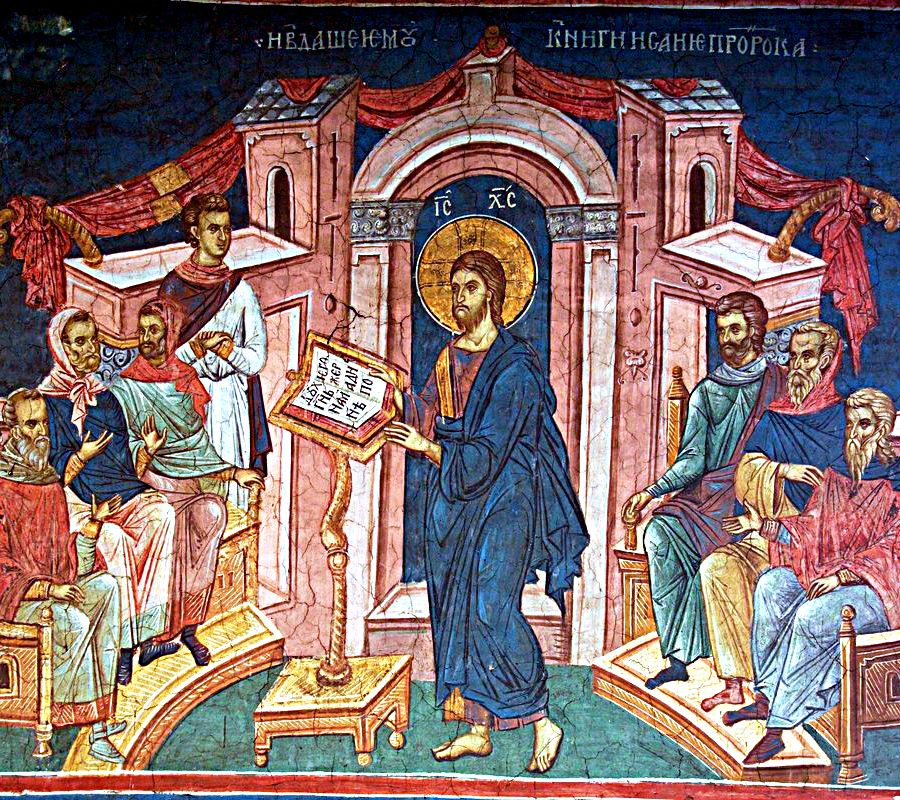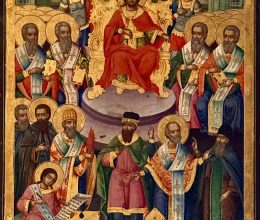
New Year! What, in fact, are we celebrating on December 31st / January 1st? And what does it mean when we speak of a civic or secular New Year? It is the moment when the entire world enters into the next year, that is, the beginning of the New Year. We are speaking here of a civic celebration, not a church one. Even the so-called “Vasilica”, January 1st, the New Year according to the Julian calendar, a tradition associated with St. Basil the Great (as this saint is commemorated on the same day), along with the Feast of the Circumcision of the Lord, is commonly known among the people as the “Old New Year.” Yet, there are no testimonies or prayers in the liturgy regarding the New Year. This shows that among Orthodox peoples, the New Year was not celebrated on January 1st. However, if the Church marks and approves the civic New Year, it does so because the Church exists within society, and every societal celebration includes its faithful members.
But let us take a closer look.
For those who are unaware—and likely the majority of our people are not—the Church also has its own celebration of the New Year, but it takes place in a completely different atmosphere and on a completely different date. That date is September 1st / 14th.
In ancient times, the month of September was the beginning of the new civic year among the Jews (Exodus 23:16). It was a month of gathering harvests and offering sacrifices of thanksgiving to God. It was during this time of celebration that the Lord Jesus entered the synagogue in Nazareth, opened the book of the Prophet Isaiah, and read the words: “The Spirit of the Lord God is upon Me, because the Lord has anointed Me to preach good tidings to the poor; He has sent Me to heal the brokenhearted, to proclaim liberty to the captives, and the opening of the prison to those who are bound; to proclaim the acceptable year of the Lord, and the day of vengeance of our God; to comfort all who mourn” (Isaiah 61:1-2).

Later, during the reign of Emperor Diocletian, the word indict was used to mark each new year. This term—indict or indiction—originally referred to an annual tax in produce, introduced by this emperor. The tax amount was determined based on a census taken every 15 years. The term indict came to refer both to the 15-year period itself and to each individual year within that cycle. The start of the year fell on September 1st, when the harvest was collected, and taxes were paid.
Later, the First Ecumenical Council decreed that the Church year should also begin on September 1st. It is important to note that the 4th century was a golden age for the Church. The era of martyrdom had ended, and Christians were free to practice their liturgies, yet the Church did not forget the heroic struggles of the martyrs. The faithful felt a deep need to preserve these memories, which led to the formation of the ecclesiastical calendar. In honor of the martyrs, the previous historical era was called the “Era of Diocletian” or the “Era of the Martyrs.”
For a long time in the Christian world, both the civic and ecclesiastical year were marked on September 1st. Later, the civic New Year was moved to January 1st, first in the West, in Europe. Historical facts point to possible reasons why the Western world shifted the tradition of celebrating the New Year from September 1st to January 1st. This tradition was connected to the Roman pagan world. According to the Julian calendar, January 1st was considered the start of the New Year. In Roman pagan society, the Romans celebrated the god Janus (from whom the month of January derives its name) and the main day of Saturnalia, as well as the beginning of the New Year from the time of the emperors. This day was celebrated with great festivity and joy. Friends sent each other gifts called Strenae, in honor of the god Strena, and they held feasts, spent the nights singing, dancing, and watching theatrical performances. These celebrations lasted several days. With the liberation of Christianity and the establishment of its traditions, all participation in these pagan gatherings was prohibited. In the 7th century, with the arrival of pagans from Flanders and Holland, attempts were made to reestablish the tradition of celebrating the New Year on January 1st in this way. But it was once again suppressed, until finally, in 1582, with the introduction of the Gregorian calendar, the West formally decided to mark the New Year on January 1st.
In the East, the situation was different. In Russia, both the church and civic calendars began on September 1st until the reign of Peter the Great. Driven by his interest in Western ways of life, Peter set out for Europe to learn the customs of the Western nations and implement them in his own, in his view, “backward” country. Thus, Peter adopted the practice of celebrating the New Year on January 1st. New Year’s became a secular holiday celebrated after the Nativity of Christ, which until the revolution of 1917 fell on December 25th. With the revolution, another calendar reform was implemented: the Julian calendar was replaced with the Gregorian calendar (new style), so that the celebration of the New Year began to fall just before Christmas, which under this reform began to be celebrated on January 7th. This created confusion among those who observed spiritual tradition: How should we celebrate the New Year, and should we celebrate it at all? The answer to this question is another topic entirely.
When it comes to calendars, it is helpful to clarify that today two calendars exist: the ancient Julian calendar, crafted in 46 BC by the Alexandrian astronomer Sosigenes, under the initiative of the Roman ruler Gaius Julius Caesar, from whom it takes its name. This calendar was adopted by the Church in the 4th century with some modifications. However, the Julian calendar is not entirely accurate: it differs by 11 minutes and 14 seconds from the true solar (tropical) year. Over 400 years, this discrepancy increased to 3 days, 2 hours, 53 minutes, and 20 seconds, and by 1700, it amounted to a full 10 days. Today, the difference stands at 13 days.
The later Gregorian calendar was introduced by Pope Gregory in the late 16th century. By the Middle Ages, scientists had already noticed the inaccuracy of the Julian calendar. Therefore, at the initiative of the pope, a commission of astronomers and mathematicians was formed in 1576 to reform the Julian calendar. The commission proposed specific measures for calendar reform, which were accepted by the pope on February 24, 1582, in a papal bull. Among other things, it was decreed that the vernal equinox should always be fixed on March 21st. Furthermore, to correct the existing 10-day difference between the Julian and real (tropical) year, it was decided that October 5th, 1582, would be considered October 15th.

This calendar became the primary one in Catholic Europe. Over time, for practical reasons, other nations gradually adopted it, and today it is used globally.
Sadly, for similar reasons, all holidays were long ago translated onto the Gregorian calendar. Few among the newer generations know that January 14th, commonly celebrated as the “Old New Year,” is actually January 1st (this date is also reflected in the liturgy), precisely due to the 13 extra days that the Gregorian calendar removed from the year. Often in the Orthodox world, there is a mistake made out of ignorance. The Circumcision of the Lord, celebrated on January 14th along with the feast of St. Basil the Great, is mistakenly considered the beginning of the new church year (“Vasilica”). If we go back 13 days, the number of days removed by the calendar reform, this feast would indeed fall on January 1st, coinciding with the civic New Year, with which the Church has little connection. However, because the Church exists within society and not apart from it, it respects the significance of the civic New Year, though it is neither a church nor a Christian holiday.
The Church celebrates its New Year, but on a different date and in a completely different atmosphere. A joyful atmosphere, yes, but one of spiritual and solemn joy. For the Christian, the New Year is a feast that, in Church terms, is celebrated on September 1st / 14th. And during this time, no festivities are practiced. Every New Year begins with the exclamation: “Blessed is the Kingdom of the Father, and of the Son, and of the Holy Spirit, now and ever, and unto the ages of ages. Amen.” This feast exists in our calendar and is called “The Beginning of the New Year.”















